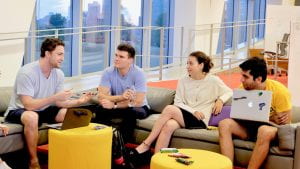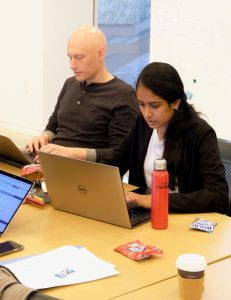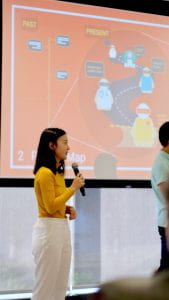Last week was the first official sprint at Cornell Tech for the Product Studio, it was an exciting time for all the teams working on their various projects. Studio Sprints are 24-Hour period each month during which there are no classes so teams can focus their energy on product and business development wok for their challenges.
The goal of the Sprint was to narrow down to 3 main ideas from the 120 to 150 ideas generated by each team. Narrowing down to our top 3 ideas followed a three-step approach. First it involved a method of Web Based Screening, which emphasizes low accuracy and high efficiency when evaluating ideas. Each team was paired up with another team where each team would give the other team a 10-minute presentation about their research. Each team then sets up a Darwinator tournament where members from both teams get to vote. Based on the results of the voting process each team selects their top 6 to 10 ideas.

The web-based screening was followed by an Idea Workshop, which involves a multiple vote prediction market to determine the top 3 ideas. Members from the team will divide the 6 to 10 ideas among themselves and develop a 1-minute pitch for each idea. After which, team members will vote for the best ideas and discuss why they voted the way they did to select the top 3 finalists.

The final step is Criteria Based Screening, which emphasizes high accuracy and low efficiency when evaluating ideas. It involves a much more in-depth value creation analysis, which will allow teams to narrow down to one final idea. To reach that goal, we developed elevator pitches for our 3 finalists, which we presented to other teams. The goal of the elevator pitch was for us to demonstrate that we have followed a rigorous process to find distinctive and non-obvious ideas.
It was incredible to see the different ideas that the teams came up with! For instance, Jenny Yi (B.Arch ’21) and her team are coming up with a design solution that allows patients and doctors to easily share credentials and health reports. Daisy Dai (B.Arch ’21) is working with her team to create a design solution that improves employees’ productivity in the workplace.



An important part of the sprint and the overall studio culture is the peer-to-peer engagement between students. We were able to practice and develop the skills required to generate ideas, receive and give feedback and validation, and address blockers and risks. Moreover, it immersed us into the world of innovation as a systematic process of tackling relevant business and/or social problems. By using a practical hands-on approach, it provided us with the space to design new ventures, propositions and services that allowed us to exercise our foresight and insight muscles in the process of opportunity creation. At the end of the process, we were able to propose a concrete, feasible, viable and relevant innovation product.
